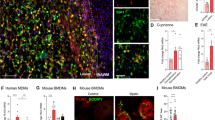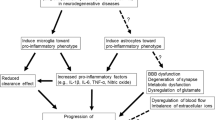Abstract
Homer, also designated Vesl, is one member of the newly found postsynaptic density scaffold proteins, playing a vital role in maintaining synaptic integrity, regulating intracellular calcium mobilization, and being critical for the regulation of cellular apoptosis. However, its function in the inflamed central nervous system (CNS) is not fully elucidated. Here, we investigated the role of Homer1b/c, a long form of Homer1, in lipopolysaccharide (LPS) induced neuroinflammation in CNS. Western blot analysis indicated that LPS administration significantly increased the expression of Homer1b/c in rat brain. Moreover, double immunofluorescent staining suggested Homer1b/c was mainly distributed in the cytoplasm of neurons and had a close association with cleaved caspase-3 level in neurons in rat brain after LPS injection. In vitro studies indicated that up-regulation of Homer1b/c might be related to the subsequent apoptosis in neurons treated by conditioned media (CM), collected from LPS-stimulated mixed glial cultures (MGC). We also found down-regulation of Homer1b/c partly blocked the increase of cleaved caspase-3 and the proportion of Bax/Bcl-2 in neurons induced by MGC-CM. Taken together, these findings suggested that Homer1b/c might promote neuronal apoptosis via the Bax/Bcl-2 dependent pathway during neuroinflammation in CNS, and inhibiting Homer1b/c expression might provide a novel neuroprotective strategy against the inflammation-related neuronal apoptosis.






Similar content being viewed by others
References
Choo XY, Alukaidey L, White AR, Grubman A (2013) Neuroinflammation and copper in Alzheimer’s disease. Int J Alzheimers Dis 2013:145345
Zinger A, Barcia C, Herrero MT, Guillemin GJ (2011) The involvement of neuroinflammation and kynurenine pathway in Parkinson’s disease. Parkinsons Dis 2011:716859
De Santi L, Polimeni G, Cuzzocrea S, Esposito E, Sessa E, Annunziata P, Bramanti P (2011) Neuroinflammation and neuroprotection: an update on (future) neurotrophin-related strategies in multiple sclerosis treatment. Curr Med Chem 18:1775–1784
Finnie JW (2013) Neuroinflammation: beneficial and detrimental effects after traumatic brain injury. Inflammopharmacology 21:309–320
Alexander JK, Popovich PG (2009) Neuroinflammation in spinal cord injury: therapeutic targets for neuroprotection and regeneration. Prog Brain Res 175:125–137
Zou J, Vetreno RP, Crews FT (2012) ATP-P2X7 receptor signaling controls basal and TNFalpha-stimulated glial cell proliferation. Glia 60:661–673
Bian Q, Kato T, Monji A, Hashioka S, Mizoguchi Y, Horikawa H, Kanba S (2008) The effect of atypical antipsychotics, perospirone, ziprasidone and quetiapine on microglial activation induced by interferon-gamma. Prog Neuropsychopharmacol Biol Psychiatry 32:42–48
Gavilan MP, Revilla E, Pintado C, Castano A, Vizuete ML, Moreno-Gonzalez I, Baglietto-Vargas D, Sanchez-Varo R, Vitorica J, Gutierrez A, Ruano D (2007) Molecular and cellular characterization of the age-related neuroinflammatory processes occurring in normal rat hippocampus: potential relation with the loss of somatostatin GABAergic neurons. J Neurochem 103:984–996
Amiraslani B, Sabouni F, Abbasi S, Nazem H, Sabet M (2012) Recognition of betaine as an inhibitor of lipopolysaccharide-induced nitric oxide production in activated microglial cells. Iran Biomed J 16:84–89
Ubogu EE, Cossoy MB, Ransohoff RM (2006) The expression and function of chemokines involved in CNS inflammation. Trends Pharmacol Sci 27:48–55
Guo RB, Wang GF, Zhao AP, Gu J, Sun XL, Hu G (2012) Paeoniflorin protects against ischemia-induced brain damages in rats via inhibiting MAPKs/NF-kappaB-mediated inflammatory responses. PLoS One 7:e49701
Jardin I, Lopez JJ, Berna-Erro A, Salido GM, Rosado JA (2013) Homer proteins in Ca(2)(+) entry. IUBMB Life 65:497–504
Pouliquin P, Pace SM, Dulhunty AF (2009) In vitro modulation of the cardiac ryanodine receptor activity by Homer1. Pflugers Arch 458:723–732
Wang Y, Fei Z, Ma YH, Liu WB, Zhu J, Zhang C, Lin W, Qu Y (2012) VEGF upregulates Homer 1a gene expression via the mitogen-activated protein kinase cascade in cultured cortex neurons. Neurosci Lett 515:44–49
Wagner KV, Hartmann J, Mangold K, Wang XD, Labermaier C, Liebl C, Wolf M, Gassen NC, Holsboer F, Rein T, Muller MB, Schmidt MV (2013) Homer1 mediates acute stress-induced cognitive deficits in the dorsal hippocampus. J Neurosci 33:3857–3864
Ghasemzadeh MB, Vasudevan P, Mueller C, Seubert C, Mantsch JR (2009) Neuroadaptations in the cellular and postsynaptic group 1 metabotropic glutamate receptor mGluR5 and Homer proteins following extinction of cocaine self-administration. Neurosci Lett 452:167–171
Murotomi K, Takagi N, Muroyama A, Kaji N, Takeo S, Tanonaka K (2012) Transient focal cerebral ischemia differentially decreases Homer1a and 1b/c contents in the postsynaptic density. Neurosci Lett 515:92–96
Chen T, Fei F, Jiang XF, Zhang L, Qu Y, Huo K, Fei Z (2012) Down-regulation of Homer1b/c attenuates glutamate-mediated excitotoxicity through endoplasmic reticulum and mitochondria pathways in rat cortical neurons. Free Radic Biol Med 52:208–217
Bonow RH, Aid S, Zhang Y, Becker KG, Bosetti F (2009) The brain expression of genes involved in inflammatory response, the ribosome, and learning and memory is altered by centrally injected lipopolysaccharide in mice. Pharmacogenomics J 9:116–126
Abbasian M, Sayyah M, Babapour V, Mahdian R, Choopani S, Kaviani B (2012) Upregulation of connexins 30 and 32 gap junctions in rat hippocampus at transcription level by chronic central injection of lipopolysaccharide. Iran Biomed J 16:127–132
Renton KW, Dibb S, Levatte TL (1999) Lipopolysaccharide evokes the modulation of brain cytochrome P4501A in the rat. Brain Res 842:139–147
Wang Y, Liu Y, Chen Y, Shi S, Qin J, Xiao F, Zhou D, Lu M, Lu Q, Shen A (2009) Peripheral nerve injury induces down-regulation of Foxo3a and p27kip1 in rat dorsal root ganglia. Neurochem Res 34:891–898
Smith TH, Ngwainmbi J, Grider JR, Dewey WL, Akbarali HI (2013) An in vitro preparation of isolated enteric neurons and glia from the myenteric plexus of the adult mouse. J Vis Exp. doi:10.3791/50688
Cao M, Tan X, Jin W, Zheng H, Xu W, Rui Y, Li L, Cao J, Wu X, Cui G, Ke K, Gao Y (2013) Upregulation of Ras homolog enriched in the brain (Rheb) in lipopolysaccharide-induced neuroinflammation. Neurochem Int 62:406–417
Konigsmark BW, Murphy EA (1970) Neuronal populations in the human brain. Nature 228:1335–1336
McNamee EN, Griffin EW, Ryan KM, Ryan KJ, Heffernan S, Harkin A, Connor TJ (2010) Noradrenaline acting at beta-adrenoceptors induces expression of IL-1beta and its negative regulators IL-1ra and IL-1RII, and drives an overall anti-inflammatory phenotype in rat cortex. Neuropharmacology 59:37–48
O’Sullivan JB, Ryan KM, Curtin NM, Harkin A, Connor TJ (2009) Noradrenaline reuptake inhibitors limit neuroinflammation in rat cortex following a systemic inflammatory challenge: implications for depression and neurodegeneration. Int J Neuropsychopharmacol 12:687–699
Baby N, Patnala R, Ling EA, Dheen ST (2014) Nanomedicine and its application in treatment of microglia-mediated neuroinflammation. Curr Med Chem 21:4215–4226
Wang SM, Lee YC, Ko CY, Lai MD, Lin DY, Pao PC, Chi JY, Hsiao YW, Liu TL, Wang JM (2014) Increase of zinc finger protein 179 in response to CCAAT/enhancer binding protein delta conferring an antiapoptotic effect in astrocytes of Alzheimer’s disease. Mol Neurobiol. doi:10.1007/s12035-014-8714-9
Su JJ, Pan H, Zhou HG, Tang YP, Dong Q, Liu JR (2014) Acid-sensing ion channels activation and hypoxia upregulate Homer1a expression. CNS Neurosci Ther 20:264–274
Li Y, Popko J, Krogh KA, Thayer SA (2013) Epileptiform stimulus increases Homer 1a expression to modulate synapse number and activity in hippocampal cultures. J Neurophysiol 109:1494–1504
Minami I, Kengaku M, Smitt PS, Shigemoto R, Hirano T (2003) Long-term potentiation of mGluR1 activity by depolarization-induced Homer1a in mouse cerebellar Purkinje neurons. Eur J Neurosci 17:1023–1032
Zhang GC, Mao LM, Liu XY, Parelkar NK, Arora A, Yang L, Hains M, Fibuch EE, Wang JQ (2007) In vivo regulation of Homer1a expression in the striatum by cocaine. Mol Pharmacol 71:1148–1158
Zeng X, Pan ZG, Shao Y, Wu XN, Liu SX, Li NL, Wang WM (2013) SKF-96365 attenuates toxin-induced neuronal injury through opposite regulatory effects on Homer1a and Homer1b/c in cultured rat mesencephalic cells. Neurosci Lett 543:183–188
Acknowledgments
This study was supported by the Nantong City Social Development Projects Funds (HS 2012032) and a project funded by the Priority Academic Program Development of Jiangsu Higher Education Institutions (PAPD), Nantong University graduate scientific and technological innovation projects (YKC13069).
Conflict of interest
All authors declare that they have no conflicts of interest.
Author information
Authors and Affiliations
Corresponding author
Additional information
Zhiming Cui and Li Zhou have contributed equally to this work and shared first author.
Rights and permissions
About this article
Cite this article
Cui, Z., Zhou, L., Liu, C. et al. The Role of Homer1b/c in Neuronal Apoptosis Following LPS-Induced Neuroinflammation. Neurochem Res 40, 204–215 (2015). https://doi.org/10.1007/s11064-014-1460-6
Received:
Revised:
Accepted:
Published:
Issue Date:
DOI: https://doi.org/10.1007/s11064-014-1460-6




